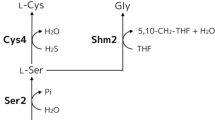Abstract
We developed a novel enzymatic glutathione (GSH) production system using Saccharomyces cerevisiae as a whole-cell biocatalyst, and improved its GSH productivity by metabolic engineering. We demonstrated that the metabolic engineering of GSH pathway and ATP regeneration can significantly improve GSH productivity by up to 1.7-fold higher compared with the parental strain, respectively. Furthermore, the combination of both improvements in GSH pathway and ATP regeneration is more effective (2.6-fold) than either improvement individually for GSH enzymatic production using yeast. The improved whole-cell biocatalyst indicates its great potential for applications to other kinds of ATP-dependent bioproduction.





Similar content being viewed by others
References
Chen DC, Yang BC, Kuo TT (1992) One-step transformation of yeast in stationary phase. Curr Genet 21:83–84
Chow CKC, Palecek SP (2004) Enzyme encapsulation in permeabilized Saccharomyces cerevisiae cells. Biotechnol Prog 20:449–456
Dröge W, Breitkreutz R (2000) Glutathione and immune function. Proc Nutr Soc 59:595–600
Eydallin G, Viale AM, Morán-Zorzano MT, Muñoz FJ, Montero M, Baroja-Fernández E, Pozueta-Romero J (2007) Genome-wide screening of genes affecting glycogen metabolism in Escherichia coli K-12. FEBS Lett 581:2947–2953
Eydallin G, Montero M, Almagro G, Sesma MT, Viale AM, Muñoz FJ, Rahimpour M, Baroja-Fernández E, Pozueta-Romero J (2010) Genome-wide screening of genes whose enhanced expression affects glycogen accumulation in Escherichia coli. DNA Res 17:61–71
Flohé L (1985) The glutathione peroxidase reaction: molecular basis of the antioxidant function of selenium in mammals. Curr Top Cell Regul 27:473–478
Hara KY, Mori H (2006) An efficient method for quantitative determination of cellular ATP synthetic activity. J Biomol Screen 11:310–317
Hara KY (2009a) Permeable cell assay: a method for high-throughput measurement of cellular ATP synthetic activity. Methods Mol Biol. 577:251–258
Hara KY, Shimodate N, Hirokawa Y, Ito M, Baba T, Mori H, Mori H (2009b) Glutathione production by efficient ATP-regenerating Escherichia coli mutants. FEMS Microbiol Lett 297:217–224
Ishii J, Izawa K, Matsumura S, Wakamura K, Tanino T, Tanaka T, Ogino C, Fukuda H, Kondo A (2009) A simple and immediate method for simultaneously evaluating expression level and plasmid maintenance in yeast. J Biochem 145:701–708
Li Y, Wei G, Chen J (2004) Glutathione: a review on biotechnological production. Appl Microbiol Biotechnol 66:233–242
Li W, Li Z, Ye Q (2010) Enzymatic synthesis of glutathione using yeast cells in two-stage reaction. Bioprocess Biosyst Eng 33:675–682
Liao X, Deng T, Zhu Y, Du G, Chen J (2007) Enhancement of glutathione production by altering adenosine metabolism of Escherichia coli in a coupled ATP regeneration system with Saccharomyces cerevisiae. J Appl Microbiol 104:345–352
Meister A, Andersen ME (1983) Glutathione. Annu Rev Biochem 52:711–760
Murata K, Tani K, Kato J, Chibata I (1981) Glycolytic pathway as an ATP generation system and its application to the production of glutathione and NADP. Enzyme Microb Technol 3:233–242
Penninckx MJ (2000) A short review on the role of glutathione in the response of yeasts to nutritional, environmental, and oxidative stresses. Enzyme Microb Technol 26:737–742
Penninckx MJ (2002) An overview on glutathione in Saccharomyces versus non-conventional yeasts. FEMS Yeast Res 2:295–305
Ray S, Watkins DN, Misso NL, Thompson PJ (2002) Oxidant stress induces gamma-glutamylcysteine synthetase and glutathione synthesis in human bronchial epithelial NCI-H292 cells. Clin Exp Allergy 32:571–577
Rolseth V, Djurhuus R, Svardal AM (2002) Additive toxicity of limonene and 50% oxygen and the role of glutathione in detoxification in human lung cells. Toxicology 170:75–88
Singh RJ (2002) Glutathione: a marker and antioxidant for aging. J Lab Clin Med 140:380–381
Tate S, Meister A (1981) γ-Glutamyltranspeptidase: catalytical, structural and functional aspects. Mol Cell Biochem 39:357–368
Thon VJ, Vigneron-Lesens C, Marianne-Pepin T, Montreuil J, Decq A, Rachez C, Ball SG, Cannon JF (1992) Coordinate regulation of glycogen metabolism in the yeast Saccharomyces cerevisiae. Induction of glycogen branching enzyme. J Biol Chem 267:15224–15228
Vartanyan LS, Gurevich S, Kozachenko AI, Nagler LG, Lozovskaya EL, Burlakova EB (2000) Changes in superoxide production rate and in superoxide dismutase and glutathione peroxidase activities in subcellular organelles in mouse liver under exposure to low doses of low-intensity radiation. Biochem (Mosc) 65:442–446
Wei G, Li Y, Du G, Chen J (2003) Effect of surfactants on extracellular accumulation of glutathione by Saccharomyces cerevisiae. Process Biochem 38:1133–1138
Wilson WA, Hughes WE, Tomamichel W, Roach PJ (2004) Increased glycogen storage in yeast results in less branched glycogen. Biochem Biophys Res Commun 320:416–423
Yamada R, Taniguchi N, Tanaka T, Ogino C, Fukuda H, Kondo A (2010) Cocktail δ-integration: a novel method to construct cellulolytic enzyme expression ratio-optimized. Microb Cell Fact 9:32–39
Yoshida K, Hariki T, Inoue H, Nakamura T (2002) External skin preparation for whitening. JP Patent 2, 002, 284, 664
Acknowledgments
We are grateful to Dr. J. Ishii (Organization of Advanced Science and Technology, Kobe University) for providing us with pGK402 and pGK405 plasmids. We thank Dr. Takashi Kondo, Dr. Naoko Okai, and Dr. Kazunori Nakashima (Organization of Advanced Science and Technology, Kobe University) for their helpful discussion. This study was supported by the Special Coordination Funds for Promoting Science and Technology, Creation of Innovation Centers for Advanced Interdisciplinary Research Areas (Innovative Bioproduction Kobe), MEXT, Japan. Hara KY was supported by Grant-in-Aid for Young Scientists (B) (18769004, 22760608).
Author information
Authors and Affiliations
Corresponding author
Additional information
Hideyo Yoshida and Kiyotaka Y. Hara contibuted equally in this work.
Rights and permissions
About this article
Cite this article
Yoshida, H., Hara, K.Y., Kiriyama, K. et al. Enzymatic glutathione production using metabolically engineered Saccharomyces cerevisiae as a whole-cell biocatalyst. Appl Microbiol Biotechnol 91, 1001–1006 (2011). https://doi.org/10.1007/s00253-011-3196-4
Received:
Revised:
Accepted:
Published:
Issue Date:
DOI: https://doi.org/10.1007/s00253-011-3196-4




